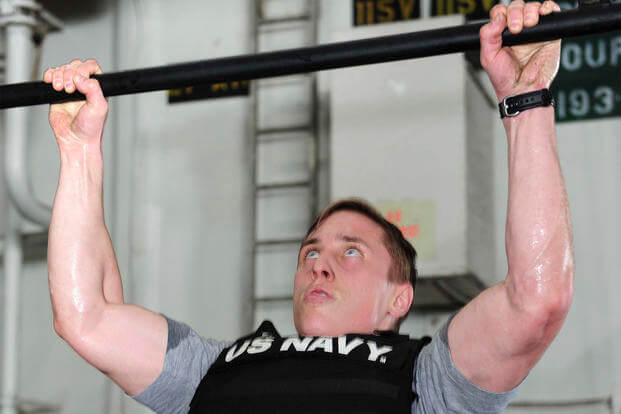Here is a challenging but quick workout to add to your upper-body day and see where you rank on a spectrum of training when preparing for calisthenics and weighted calisthenics fitness tests. We have tried a few options and noticed the training group broke out into three categories of strength and strength-endurance. This may be difficult if the gym you use is crowded and people want to use the bench while you are doing other exercises, but here is the challenge:
Repeat three times.
- Body-weight bench press: max reps
- Weight-vest pull-ups: max reps
- Push-ups: max for one minute (unweighted)
- Pull-ups: max reps (unweighted)
There is no rest between exercises until the circuit is complete. Then you can rest as needed before you start the next round of this four-exercise circuit. Typically, we do an easy active rest or walking, jogging, or biking for 3-5 minutes before starting the next set.
Here are some interesting results within a high-level training group in various stages of preparation:
These exercises, chosen as pull-ups and bench presses, are the "heavy weightlifting" calisthenics and an above-average lift, requiring pulling and pushing 100% of your body weight. Weighted pull-ups and the body-weight bench press are events within tactical fitness tests, as are the non-weight exercises of pull-ups and push-ups in military fitness tests. Honestly, doing these two upper-body activities well sets you apart within the fitness world. Add a 20-pound weight vest especially to a pull-up, and the level of strength needed increases. Weight-vest pull-ups are also a common tactical fitness test in the special operations communities. However, the inability to do body-weight bench presses can be traded in this test with the option for weight-vest push-ups.
The New to the Group Segment
Within the group, varying levels of athletic history determine your fitness level on these assessments. For instance, most people in this group did only a few weighted-vest pull-ups but did more non-weighted pull-ups. This group was also unable to do body-weight bench presses. For instance, a sample in this group could do 1-2 weight-vest pull-ups and 50% fewer weight-vest push-ups (than non-weighted scores) but could do 6-7 non-weighted pull-ups.
These results are part conditioning but also a combination of strength and endurance weaknesses. By the third set, this group could not do any weight-vest pull-ups and less than 50% of the first-set numbers of the non-weighted options. This is typical for newly trained candidates making transitions into more strength-endurance training.
Keep training and working on total volume with a few sets of weighted calisthenics in your workouts. A cycle of strength training, calisthenics and cardio will turn this group into the next levels below in about 12-16 weeks.
Intermediate Segment A
The Intermediate Group A performed well in the first set but decreased performance significantly (50% or more) in the last two sets. For instance, the weight-vest pull-ups were in the 7-9 range for the first set, as were the non-weighted pull-ups. Conditioning played more of a role in the last two sets for this group, resulting in a significant reduction in performance. This group also could do fewer than 4-5 reps of body-weight bench presses but 40+ in the non-weighted push-ups set.
Intermediate Segment B
This group saw similar results to those above, but they recovered quicker and did not have a steep decline in performance (less than a 25% decrease) in the latter sets. However, neither group was in the double digits of performance. Both weighted and non-weighted pull-ups were similar in all three sets. Many in this group could do more than 10+ body-weight bench presses and 40+ on the push-ups (non-weighted).
Advanced Segment
This group scored double digits on every event for all three sets. One example is 18 weight-vest pull-ups, 20 body-weight bench presses, then 18 non-weighted pull-ups and 50+ on the push-ups for all three sets, with only a 10% reduction in performance on the last set. This is a sign of pound-for-pound strength, muscle stamina and the ability to recover quickly.
Building up to this level is a process that includes an athletic history that could span years of sports, such as wrestling, gymnastics and martial arts, but also doing calisthenics and adding lifting in the offseason. This is strength/endurance conditioning at what I would call an advanced level.
Active recovery from an easy jog or bike after this testing circuit also benefited those in the higher-performing groups, versus those who sat on the bench for 4-5 minutes. Active recovery has been proven to help the muscles clear lactate faster. If you are feeling nauseated, greatly fatigued or starting to cramp, keep moving as the lactate buildup from max effort sets will clear faster.
But your level of conditioning also plays a vital role in your ability to recover quickly. Combining strength, stamina and cardio endurance training will improve these scores, but programming effectively is challenging as recovery (sleep, nutrition, hydration) must be maximized to see progress truly.
See where you rank on the spectrum of strength-muscle stamina by adding this circuit to your upper-body day.
Stew Smith is a former Navy SEAL and fitness author certified as a Strength and Conditioning Specialist (CSCS) with the National Strength and Conditioning Association. Visit his Fitness eBook store if you're looking to start a workout program to create a healthy lifestyle. Send your fitness questions to stew@stewsmith.com.
Want to Learn More About Military Life?
Whether you're thinking of joining the military, looking for fitness and basic training tips, or keeping up with military life and benefits, Military.com has you covered. Subscribe to Military.com to have military news, updates and resources delivered directly to your inbox.


















